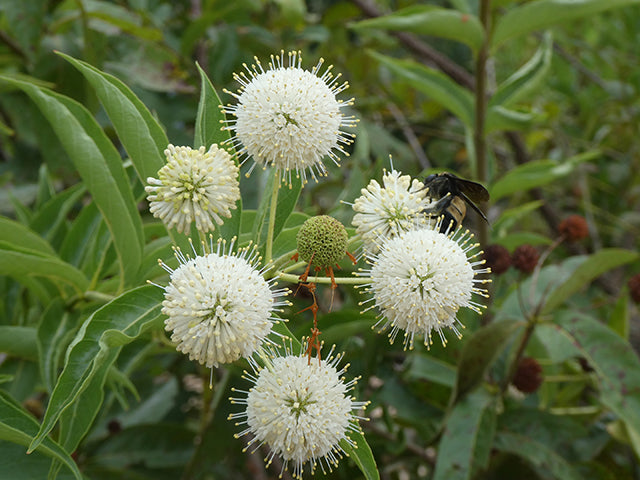Buttonbush (Cephalanthus occidentalis)
Buttonbush (Cephalanthus occidentalis)
Low stock: 9 left
Couldn't load pickup availability
Cephalanthus occidentalis L.
Common Buttonbush, Buttonbush, Button Willow, Honey Bells, Honeybells, Honey Balls, Honeyballs, Button-bush
Rubiaceae (Madder Family)
Synonym(s): Cephalanthus occidentalis var. californicus, Cephalanthus occidentalis var. pubescens
USDA Symbol: CEOC2
USDA Native Status: L48 (N), CAN (N)
Common buttonbush is a multi-stemmed shrub which grows 6-12 ft. or occasionally taller. Leaves in pairs or in threes, petiolate; blade up to 8 inches long, ovate to narrower, sometimes 1/3 or less as wide as long, with a pointed tip and rounded to tapered base, smooth margins and glossy upper surface, lower surface duller. Glossy, dark-green leaves lack significant fall color. Flowers small, borne in distinctive, dense, spherical clusters (heads) with a fringe of pistils protruded beyond the white corollas. Long-lasting, unusual blossoms are white or pale-pink, one-inch globes. Subsequent rounded masses of nutlets persist through the winter. Trunks are often twisted. Spreading, much-branched shrub or sometimes small tree with many branches (often crooked and leaning), irregular crown, balls of white flowers resembling pincushions, and buttonlike balls of fruit.
Buttonbush is a handsome ornamental suited to wet soils and is also a honey plant. Ducks and other water birds and shorebirds consume the seeds.
Plant Characteristics
Habit: Shrub
Leaf Retention: Deciduous
Leaf Complexity: Simple
Fruit Type: Nut
Size Notes: Up to about 12 feet tall.
Leaf: Green
Autumn Foliage: yes
Fruit: Brown, rounded ball of nutlets.
Bloom Time: Jun , Jul , Aug , Sep
Distribution
USA: AL , AR , AZ , CA , CT , DC , DE , FL , GA , IA , IL , IN , KS , KY , LA , MA , MD , ME , MI , MN , MO , MS , NC , NE , NH , NJ , NY , OH , OK , PA , RI , SC , TN , TX , VA , VT , WI , WV
Canada: NB , NS , ON , PE , QC
Native Distribution: N.B. & Que. to upper Mississippi R. Valley, e. NE & e. KS, s. to FL & TX
Native Habitat: In swamps, around ponds and margins of streams throughout the state. Sand, loam, clay, limestone; moist, poor drainage or standing water okay. Prairie swales; lake, marsh, creek & swamp margins; dry, limestone bluffs
Growing Conditions
Water Use: HighLight Requirement: Part Shade , Shade
Soil Moisture: Moist , Wet
Soil pH: Circumneutral (pH 6.8-7.2)
CaCO3 Tolerance: Medium
Cold Tolerant: yes
Soil Description: Limestone-based, Sandy, Sandy Loam, Medium Loam, Clay Loam, Clay
Conditions Comments: Common buttonbush is a spreading, multi-branched shrub or sometimes small tree with many branches (often crooked and leaning), irregular crown, balls of white flowers resembling pincushions, and buttonlike balls of fruit. Buttonbush is a handsome ornamental suited to wet soils and is also a honey plant. Ducks and other water birds and shorebirds consume the seeds.
Benefit
Use Ornamental: Showy, Attractive, Blooms ornamental, Fruits ornamental, Bog or pond area, Aromatic, Water gardenUse Wildlife: Nectar-butterflies, Nectar-bees, Nectar-insects, Fruit-birds
Warning: The poisonous foliage of this abundant and widespread species is unpalatable to livestock. The bitter bark has served in home remedies, but its medicinal value is doubtful.
Conspicuous Flowers: yes
Fragrant Flowers: yes
Attracts: Birds , Butterflies
Nectar Source: yes
Deer Resistant: Moderate
Value to Beneficial Insects
Special Value to Native BeesSpecial Value to Bumble Bees
Special Value to Honey Bees
This information was provided by the Pollinator Program at The Xerces Society for Invertebrate Conservation.
https://www.wildflower.org/plants/result.php?id_plant=CEOC2
Image Information
Photographer: Page, LeeCity: Austin
County: Travis
State: TX
Location Notes: Lady Bird Johnson Wildflower Center.
Accession date: 2022-07-08
Filename: LMP_IMG0538.JPG
Slide Index: P1020030.JPG
Restrictions: Unrestricted
Collection: Wildflower Center Digital Library
Original Format: Digital
Orientation: Landscape
Shot: Close-up of a flowering plant.
Date Taken: 2019-09-11
NPIN Image Id: 89845


